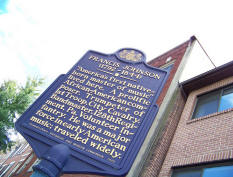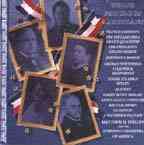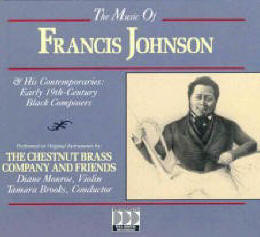Home
Blog
Composers
Musicians
Black History
Audio
About Us
Links
Musicians:
Blanke, John
Bridgetower, George A. P.
Chapman Nyaho, William H.
DePreist, James
Dworkin, Aaron Paul
Freeman, Paul
Johnson, Francis
Machado, Celso
Ngwenyama, Nokuthula
Wiggins, Thomas "Blind Tom"
Yifrashewa, Girma
AfriClassical Blog
Companion to AfriClassical.com
Guest Book
William J. Zick, Webmaster,
wzick@ameritech.net
©
Copyright 2006 - 2022
William J. Zick
All rights reserved for all content of AfriClassical.com

Francis Johnson (1792-1844) "'America's
first native-born master of music' lived here. A prolific
African-American composer. Trumpeter of First Troop, City
Cavalry. Bandmaster 178th Regiment, Pa. Volunteer
Infantry. He was a major force in early American music;
traveled widely."
(Pennsylvania Historical and Museum Commission 1992)
<http://www.flickr.com/photos/
lucindalunacy/3962867722/>

New
World Records NW 80293 (1997)

Troy
103
|
Home ->
Musicians -> Johnson, Francis B.
"Frank"
Français
1 First Major
Bandmaster
Francis B. "Frank" Johnson
was an African American bugler, bandleader and
composer born in 1792. Prof. Dominique-René de Lerma of Lawrence
University has made his research on Johnson available to this
Website. He begins:
|
Francis (or Frank) Johnson was the
first major bandmaster in the U.S. It
has long been thought he was born in
Martinique, but it is now believed he
was born in Philadelphia, known there
as a professional musician by 1812,
probably as a violinist. |
2
The
Music of Francis Johnson
Francis Johnson played the bugle, keyed bugle, cornet, violin and
other instruments. He also composed music for band. Among the recordings of his works is
The Music of Francis Johnson and His Contemporaries: Early
19th-Century Black Composers, Music Masters
7029-2-C (1990). The music is performed on original instruments
by The Chestnut Brass Company and Friends, accompanied on violin
by Diane Monroe and led by Tamara Brooks, Conductor. The CD
includes marches and dances of the period by Johnson's four
African American contemporaries in Philadelphia who also wrote
band music:
James Hemmenway, Isaac Hazzard, A.J.R.
Conner and Edward Roland.
3 Overview of Career
The liner notes for the recording begin by emphasizing the
unusual nature of Francis Johnson's professional activities:
|
The career and musical
legacy of Francis
"Frank" Johnson (1792-1844) represent one of
the most singular achievements in the history
of American music. In an era when full-time
musicians were a rarity in the United States,
Johnson fashioned a career of such variety and
importance that it would be the envy of many a
modern musician. Even more remarkable is
that Johnson, an African-American, was able
to achieve such success against a background
of racial strife which worsened even as his work
progressed.
Johnson was the composer
of over three
hundred pieces of music, the majority of which
were published. He was a renowned performer
on the keyed bugle and violin and led one of the
best bands of his time. |
4 Music Studies
The liner notes point out that information on Francis Johnson's
early life is sketchy:
|
The
sources of his musical training are likewise a
mystery, though some of his study appears to
have been with Richard Willis, an Irish keyed-bugle soloist who arrived in the United States
in 1816 and assumed leadership of the West
Point band in 1818. |
5 Keyed-Bugle
Dominique-René de Lerma
relates the origin and early use of the instrument known as the
keyed-bugle:
|
The
keyed bugle, which Johnson played
by 1818, was patented in 1810 by Joseph Halliday, an
Irish bandmaster. It was also known as the Kent bugle,
named for the Duke of Kent who called
for its use in the royal bands. |
6 First Published Work
Johnson was already well-established as a Philadelphia musician
when his first sheet music appeared, according to the liner
notes:
|
By 1818, the year of his
first published
composition, A Collection of New Cotillions,
Johnson was established as a well-known
musician in Philadelphia, then the national
cultural center. Robert Waln, author of The Hermit in America, penned the following oft-quoted portrait of Johnson in 1819: "In fine, he
is the leader of the band at all balls, public and
private; sole director of all serenades,
acceptable and unacceptable; inventor-general
of cotillions; to which add, a remarkable taste
in distorting a sentimental, simple, and
beautiful song, into a reel, jig or country-dance." |
7 Lafayette's Triumphal Tour
Strategic alliances with important
institutions contributed to the acceptance of Johnson's African
American band by White society, as we learn from the liner
notes:
|
Johnson's band, which
probably was begun to
fill a need in the Black community, shortly
became popular with the more affluent White
society as well. Two important, long-standing
associations were formed in the early 1820s
when the band became affiliated with the
Philadelphia State Fencibles (militia units at
the time contracted with their own bands) and
with the Summer Resort at Saratoga Springs,
presaging the current summer residency of the
Philadelphia Orchestra. In 1824 Johnson's
reputation was further enhanced when he
composed much of the music for the triumphal
return to Philadelphia of Revolutionary War
hero General Lafayette, who was traveling the
United States to great public acclaim and
celebration. |
Prof. De Lerma
elaborates:
|
A band
of 20 players provided music for most of the festivities
accorded General
Lafayette in 1824. |
Francis Johnson's music for
General Lafayette on this recording includes: Honor To The
Brave: Gen. Lafayette's Grand March (3:57).
8 Dances
Johnson typically
played the violin at dances, accompanied by a small ensemble, as
Prof. De Lerma recounts:
|
The
popular dances (performed indoors
with a smaller ensemble and with Johnson as violinist)
included the polka,
galop, waltz, cotillion, country dance,
reels, jigs, and quadrille. These were
played in sets, with a pattern of repeats
so, even if rather short individually, the
performances became extended. |
9 European Visit
The liner notes of the CD quote from Johnson's announcement of
his European trip:
|
In 1837
Francis Johnson announced that he and a small contingent
of his band members were departing for Europe to
"improve his musical capacity and knowledge, so as to be
able in a much greater degree than formerly to
contribute to the gratification of the public." |
Prof. De Lerma
identifies the band members who accompanied Johnson to Europe,
and notes they performed for Victoria shortly before she became
Queen of England:
|
In
November of 1837, he took William
Appo (Johnson's brother-in-law), Aaron
J. R. Connor, Edwin Roland, and Francis
V. Seymour (if not also James Hemmmenway) to
London as the first Black American musicians to visit
Europe, and to the royal court at Buckingham Palace to
play for Victoria (1838), soon to be crowned Queen of
England. |
The liner notes
summarize the activities of the musicians in Europe, and give
the approximate date of their return:
|
The
musicians remained in Europe, acquiring music, studying
continental styles and giving concerts until their
return to the United States for the Christmas season of
1838. |
10 Promenade Concerts
The liner notes recount that Johnson's band returned to
Philadelphia and began giving "promenade concerts" in the French
style:
|
Upon their return they promptly introduced Johnson's tremendously successful
Promenade Concerts a la Musard, forerunners of the modern "pops" concerts. Prominent White performers were later included in these programs, some of the first interracial performances in America. In 1842 Johnson provided the music for a ball in honor of the visiting English author Charles Dickens. |
11 North American Tour
Prof. De Lerma notes that
Johnson subsequently toured widely in
the United States, and also visited Canada:
|
His
tours (1839-1844) took him as far north as Toronto, as
far west as St. Louis. They also performed in Detroit,
Ann Arbor, Cleveland, and Louisville. |
As free Blacks, Johnson and his
band members found themselves unwelcome in Missouri, which had
entered the Union as a slave state.
12 African American Events
The liner notes tell us that Johnson and his band performed
works of Haydn and Handel at social and religious gatherings of
African Americans, and dedicated compositions to the fight
against slavery and to the Haitian Revolution:
|
Johnson remained musically active in the
Black community as well, often conducting the orchestra at church concerts, including works by Haydn and Handel. His pride in, and commitment to, his race is manifest in many of his works, notably the Recognition March
on the Independence Hayti and the music to the moving abolitionist song
The Grave of the Slave. |
13 Racial Persecution
Racist persecution was a fact of life during the career of
Francis Johnson, as the liner notes make clear in vivid detail:
|
Johnson's career was never far from the ugliest forms of racial persecution. White bands often refused to participate in parades when
Johnson's band was scheduled to appear; and when the band toured to St. Louis, Missouri,
its members were arraigned, fined and ordered from the state under laws prohibiting the entry of free Blacks. A particularly violent incident occurred near Pittsburgh: "At the close of the
concert the mob followed Mr. Johnson and his company shouting "n____" and other
opprobrious epithets, and hurling brick-bats, stones and rotten eggs in great profusion upon the unfortunate performers. One poor fellow was severely, it is feared dangerously,
wounded in the head, and others were more or less hurt. No thanks to the mobocrats that life was not taken, for they hurled their missiles
with murderous recklessness if not with murderous intention." The Tribune [NY], May
23, 1843. |
14 Death
We learn form the liner notes that a long illness near the end of
his life limited Johnson's performances but not his output of
music:
|
Johnson died in 1844 after a sustained illness. The seriousness of his condition somewhat restricted his concert acivities, but spurred a final burst of compositional productivity, perhaps to generate income for his wife and family and perhaps as well to commit as many of his ideas to paper as possible. His funeral was attended by hundreds of members of the African-American community; and his own composition,
Dirge, was played by his band at his grave. |
Prof.
De Lerma says Francis Johnson's bands continued long after his
death, under the leadership of Joseph G. Anderson:
|
His ensembles continued after his death, now known as
the Frank Johnson String and Brass Bands, led by Joseph
G. Anderson (1816-1873), disbanded about the time of the
American Civil War. |
15 Additional Recordings
Come and Trip It - Instrumental Dance Music, New World Records
NW 80293 (1997) features two works by Francis johnson, Victoria
Galop (1:08) and La Sonnambula Quadrille No. 2 (4:32).
Three pieces by Johnson can be found on
Those Fabulous
Americans, Troy 103: The Philadelphia Gray's Quickstep,
The Princeton Grand March and Johnson's March. Matthew Phillips
conducts the Symphony Orchestra of America.
16 Manuscript
Hidden in Plain Sight: Musical Treasures in the Penn Library is
an exhibit curated by Marjorie Hassen at the Music Library of
the University of Pennsylvania. It contains a signed manuscript
copy of two compositions of Francis Johnson, Favorite Waltz, or
Spanish Dance and Favorite Hop Waltz arranged for the piano,
"for Mrs. J. Reed".
17 200th Anniversary
The 200th Anniversary of the birth of Francis Johnson was
observed by the U.S. Senate by means of a Commemoration Of A
Musical Master dated July 22, 1992. Sen. Alfonse D'Amato of New
York concluded his commemoration with these words:
|
Francis Johnson is best
remembered as
progenitor of the Nation's music of martial
ardor, inventor of cotillions, a pioneer, and one
of the earliest protagonists of American
musical purism. He was a quintessential
American musical phenomenon. I ask my
colleagues to join me in remembering Francis
"Frank" Johnson on the anniversary of his birth
and always. |
18 African American
Museum
"Audacious
Freedom: African Americans in Philadelphia 1776-1876” is the new
core exhibit of the African American Museum in Philadelphia,
http://www.aampmuseum.org/. Ivan Henderson, Public Programs
Coordinator, wrote in the Guest Book of AfriClassical.com on
July 3, 2009:
|
This
site is an excellent resource for exposing the public to
music history. This has been a huge help in planning for
our current core exhibit, which explores the lives of
African Americans in Philadelphia 1776-1876. |
19 Works
Prof.
Dominique-René de Lerma
Works.
Chestnut Brass Company (1989/04).
AC: Crystal C-562 (1989).
CD: Crystal CD-562
(1989).
Chestnut Brass Company & Friends (1990/02).
CD: MusicMasters
7029-2-C.
CD: MusicMasters MMD 6
0236 F.
A collection of new cotillions, book 1, first & second setts.
1. The cymbals
[1:32]; 2. Maria Caroline [1:47]; 3. August [1:44];
Caroline [1:52];
William [1:53]; Johnson’s jig cotillion [1:47]; Ford
[1:39]; Lewis [2:03];
Francis [1:36]; Fort Erie [2:03]; The arrival [1:35];
Castillian [1:22].
Philadelphia: George Willig, 1818. David Anthony
Lofton, piano.
CD: Parallelodrome
P1001JVLIB (1989).
LP: Parallelodrome
(1989). CBMR (Aaron Horne).
A collection of new cotillions [book 2], third &
fourth setts.1. Victor [1:25];
2. Rachel [2:10]; 3. The wreath [1:55]; 4. Elizabeth
[1:32]; 5. The
garland [1:37]; 6. The promenade [1:30]; 7. The signal
[1:42]; 8. Mary
[1:58]; 9. Joseph [1:39]; 10. Eliza [1:19]; 11. The
Philadelphian [1:27;
12. Trip to Ballston [1:23]. Philadelphia: George
Willig, 1820. David
Anthony Lofton, piano.
CD: Parallelodrome
P1001JVLIB (1989).
LP: Parallelodrome
(1989). CBMR (Aaron Horne).
Honor to the brave; General Lafayette's grand march.
Philadelphia: T. Carr
for the Author, 1824 (Johnson's new cotillions and
march).
J. Bunker Clark, piano.
AC: Lerma.
Johnson's dream waltz (1826). Duration: 2:24.
Ruth Norman, piano.
LP: Opus One 39 (1978).
CBMR (Lerma).
Johnson’s march. Philadelphia: George Willig, 181?.
--- for orchestra.
Symphony Orchestra of America; Matthew H. Philips,
conductor.
CD: Albany TROY 103 (Those
fabulous Americans).
London polka.
Alan Mandel, piano.
LP: Desto DC-6445/7
(1975). CBMR (Lerma).
Philadelphia fireman's cotillion. New York: G. E. Blake,
n.d.
Alan Mandel, piano.
LP: Desto DC-6445/7
(1975). CBMR (Lerma).
Philadelphia Gray's quickstep, from Bellini’s opera I
puritani. Philadelphia:
Fiot, Meignen, 1835.
--- for orchestra.
Symphony Orchestra of America; Matthew H. Philips,
conductor.
CD: Albany TROY 103 (Those
fabulous Americans).
Princeton grand march. Duration: 2:20. Philadelphia:
Osbourne's Music
Salon, 1840 [?].
Alan Mandel, piano.
LP: Desto DC-6445/7
(1975). CBMR (Lerma).
--- for chamber orchestra, arr. by Hale Smith. Chicago: Center
for Black
Music Research.
Black Music Repertory Ensemble; Michael Morgan,
conductor
(1989/10/13).
LP: CBMR-001 (1990).
Lerma.
---- for orchestra.
Symphony Orchestra of America; Matthew H. Philips,
conductor.
CD: Albany TROY 103 (Those
fabulous Americans).
Recognition march on the independence of Hayti (c1804).
Black Music Repertory Ensemble; Kay George Roberts,
conductor; arr.
by ==
This page was last updated
on
March 5, 2022
|




